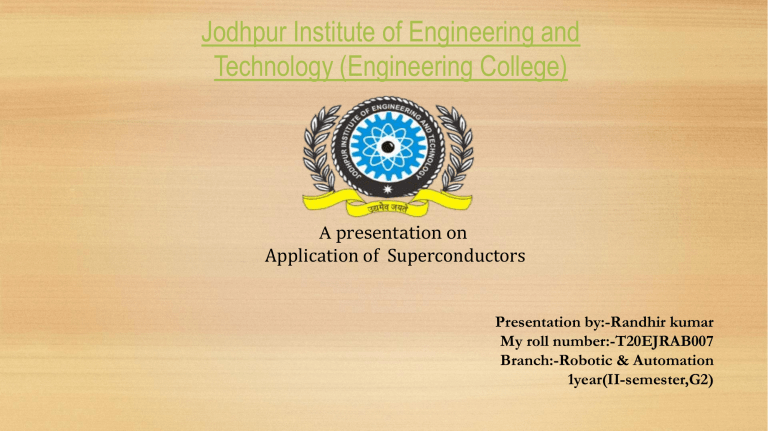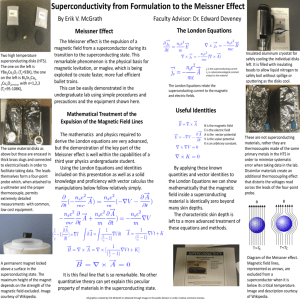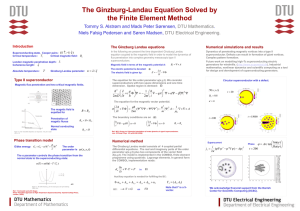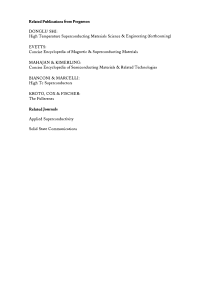
Jodhpur Institute of Engineering and Technology (Engineering College) A presentation on Application of Superconductors Presentation by:-Randhir kumar My roll number:-T20EJRAB007 Branch:-Robotic & Automation 1year(II-semester,G2) General Introduction Definition & Basic Characteristics Superconductor: is an element, inter-metallic alloy, or compound that conducts electricity without resistance below a certain temperature, magnetic field, and applied current. Observed in 1911 by H.K. Onnes in leqiud helium at temperature 4K. In 1933 Meissner and Ochsenfeld discovered that a superconducting material repels a magnetic field. This phenomenon is referred as Meissner effect. In superconductor, the electronic fluid cannot be resolved into individual electrons as in normal conductor. Instead, it consists of bound pairs of electrons known as Cooper pairs. In 1957, the BCS theory of superconductors was proposed. The theory describes superconductivity as a microscopic effect caused by a condensation of Cooper pairs into a boson-like state. Applications of Superconducting Materials Science In magnet application: Nuclear Magnetic Resonance (NMR) spectroscopy, due to advantages: high current density high magnetic field 20 T LTS/HTS hybrid magnets are using in Future Circular Collider (FCC) to deliver a 100 TeV protons. Nb resonators are used in transmitting high microwave power to electrons, protons and ion beams in an accelerators used in huge particle colliders, because of their: ultra-high quality factors excellent power-handling capability Energy & Transportation Transmission cables first generation HTS (1GHTS), basing on Bi-HTS. second generation HTS (2GHTS), basing on YBCO-HTS. Transformers:- mainly offer oil-free operation reduced ac losses, size and weight. Current limiters: fault current limiter (FCL). Generators: e.g. for wind power generators. Maglev trains. (Dimensions: 406 x 818 x 1080 mm3) Electronics wirelesscommunications: based on superconducting thin films embedded in multi-layer structures. Filter systems mostly made of 123-HTS, offering: improved coverage in rural areas Better usage of limited transmission bandwidths in densely populated areas. Josephson Junctions (JJs) Single junction devices are used as microwave frequency-mixers in radio astronomy. JJs have also been used for sensors with exceptional performance; e.g. X-ray detectors or far-infrared sensors in THz spectroscopy and scanners, particularly in space applications area, to detect very faint signals. Superconducting Quantum Interference Devices (SQUIDS); capable of detecting extremely small magnetic fields. been in use for materials characterization and evaluation, scientific instrumentation (e.g. scanning SQUID microscopes). in special applications such as geophysical exploration and archeology. Medical Magnetic Resonance Imaging (MRI); widely used as standarddiagnostic tool routinely in hospitals and surgeries. operating at magnetic fields up to 1.5 Tesla, but the number of 3 Tesla systems is increasing. Magnetocardiography (MCG) and Magnetoencephalography (MEG) systems based on SQUIDs are working on clinical research on heart and brain. New applications include Positron Emission Tomography and cancer treatment using proton therapy. Cryogenics The broader implementation of superconductive components requires cryogenic packaging. Reliable supply of liquid cryogens like Helium (LHe, 4.2K), Hydrogen (LH2, 20K), Neon (LNe, 27K) and Nitrogen (LN2, 77K) or, alternatively, reliable operation of cryocoolers adequate for these specific applications. Thousands of Magnetic Resonance Imaging (MRI) systems have been operated reliably over many years, demonstrating that cryogenics can be made invisible, efficient & reliable. Research Development in Superconductivity The initially expectations which ignored the complex nature of the new SC materials and so it took time to surmount the grain boundary problem of these ceramics; is now solved through manufacturing technologies leading to superior devices. Since then the discovery of novel superconductors continues, and an unrested progress in understanding the unique properties of HTS has been registered. A superconductor which is between LTS and HTS is MgB2. It was discovered in 2001. Another class, the Iron Picnitides, which have slightly higher Tc than MgB2, came up in 2008. Recently, the barrier of 200K as Tc was crossed in H2S under high pressure. Thank you Presentation by:-Randhir kumar






